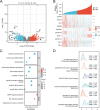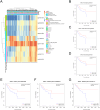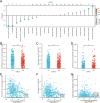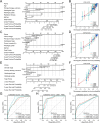Expression and prognostic value of EGF-like domain multiple 6 in uterine corpus endometrial carcinoma and its correlation with immune cell infiltration
- PMID: 40595086
- PMCID: PMC12219560
- DOI: 10.1038/s41598-025-07379-7
Expression and prognostic value of EGF-like domain multiple 6 in uterine corpus endometrial carcinoma and its correlation with immune cell infiltration
Abstract
Uterine corpus endometrial carcinoma (UCEC) is a common malignancy that affects the female reproductive tract, and it is characterized by high rates of both morbidity and mortality. This study investigated epidermal growth factor-like domain multiple 6 (EGFL6) as a potential diagnostic and prognostic biomarker in patients with UCEC. RNA sequencing data and clinical information from patients with UCEC were obtained from The Cancer Genome Atlas. Logistic regression analysis was used to assess the correlations between EGFL6 expression and clinical features. Gene Ontology, Kyoto Encyclopedia of Genes and Genomes, and Gene Set Enrichment Analysis were performed to evaluate the EGFL6-related biological characteristics and signaling pathways. Immunohistochemistry was performed using UCEC tissue microarrays to assess EGFL6 expression. The Kaplan-Meier method and Cox regression analyses were used to evaluate the prognostic significance of EGFL6. Three nomograms were developed to predict overall survival, disease-specific survival, and progression-free interval probabilities at 1, 3, and 5 years after diagnosis. The expression of EGFL6 was validated using quantitative real-time PCR. Our findings demonstrate that EGFL6 is markedly overexpressed in UCEC and is associated with unfavorable clinical characteristics, including clinical stage and histological type. Gene Ontology, Kyoto Encyclopedia of Genes and Genome and Gene Set Enrichment Analysis highlighted its possible association with various key signaling pathways. Additionally, EGFL6 expression was associated with decreased immune cell infiltration, particularly regulatory T cells (Tregs) (r = - 0.219, p < 0.001) and CD8 + T cells (r = - 0.217, p < 0.001). Overall, EGFL6 expression was associated with a poor patient prognosis in patients. In conclusion, EGFL6 is a potential biomarker for UCEC, and could greatly improve of diagnostic and prognostic evaluation.
Keywords: Biomarker; EGF-Like domain multiple 6; Immune infiltration; Prognosis; Uterine Corpus endometrial carcinoma.
© 2025. The Author(s).
Conflict of interest statement
Declarations. Competing interests: The authors declare no competing interests.
Figures








Similar articles
-
In-depth evaluation of XPR1 as a new prognostic indicator for endometrial cancer.BMC Cancer. 2025 Sep 2;25(1):1411. doi: 10.1186/s12885-025-14818-1. BMC Cancer. 2025. PMID: 40898098 Free PMC article.
-
Construction of cuproptosis-related genes risk model predicts the prognosis of Uterine Corpus Endometrial Carcinoma.Sci Rep. 2025 Jan 16;15(1):2210. doi: 10.1038/s41598-025-86756-8. Sci Rep. 2025. PMID: 39825108 Free PMC article.
-
Expression of the IL-18-related gene PTX3 correlates with clinicopathological features and prognosis in glioma patients.PeerJ. 2025 Jul 10;13:e19675. doi: 10.7717/peerj.19675. eCollection 2025. PeerJ. 2025. PMID: 40656950 Free PMC article.
-
Cost-effectiveness of using prognostic information to select women with breast cancer for adjuvant systemic therapy.Health Technol Assess. 2006 Sep;10(34):iii-iv, ix-xi, 1-204. doi: 10.3310/hta10340. Health Technol Assess. 2006. PMID: 16959170
-
Impact of residual disease as a prognostic factor for survival in women with advanced epithelial ovarian cancer after primary surgery.Cochrane Database Syst Rev. 2022 Sep 26;9(9):CD015048. doi: 10.1002/14651858.CD015048.pub2. Cochrane Database Syst Rev. 2022. PMID: 36161421 Free PMC article.
References
-
- Bray, F. et al. Global cancer statistics 2022: GLOBOCAN estimates of incidence and mortality worldwide for 36 cancers in 185 countries. Cancer J. Clin.74, 229–263 (2024). - PubMed
MeSH terms
Substances
Grants and funding
- (2024)2942./1.This project is supported by Scientific research project of Kashi University,
- (2024)2942./1.This project is supported by Scientific research project of Kashi University,
- (2024)2942./1.This project is supported by Scientific research project of Kashi University,
- (2024)2942./1.This project is supported by Scientific research project of Kashi University,
- SKL-HIDCA-2024-KY7/State key laboratory of pathogenesis, prevention and treatment of high incidence diseases in central asia fund,
LinkOut - more resources
Full Text Sources
Research Materials

